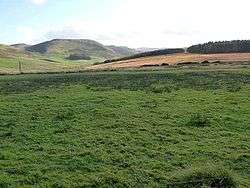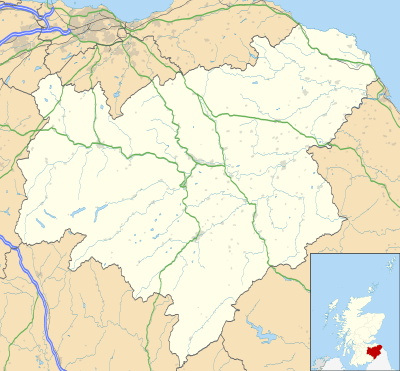Pennymuir Roman camps
The Pennymuir Roman camps are situated southeast of Jedburgh in the Scottish Borders area of Scotland, near the Anglo-Scottish border, in the former Roxburghshire. The site, alongside the course of the Roman road known as Dere Street, consists of the remains of four Roman temporary camps, a linear earthwork and an area of rig. The site is also sometimes referred to as the Towford camps.
| Pennymuir | |
|---|---|
| Scottish Borders, Scotland, UK | |
 View across Camp A at the Pennymuir Roman camps | |
 Pennymuir Location in the Scottish Borders | |
| Coordinates | 55.4181°N 2.3882°W |
| Grid reference | NT7514 |
Overview
The camps at Pennymuir lie on rough moorland in the Cheviot Hills beside Dere Street, a short distance north of Tow Ford where the Roman road crossed the Kale Water.[1] Camps A and B are considered amongst the best preserved Roman camps in Scotland.[2] These two were first recorded in 1774 by William Roy.[2]
The Pennymuir camps lie about 7 kilometres northwest of the Roman camps and fortlets at Chew Green on the English side of the Anglo-Scottish border and are located in the vicinity of Woden Law hillfort.[3][4]
Camp A
Camp A (grid reference NT754139) is the largest camp in the group.[2] It lies close to the west side of Dere Street on a platform of moderately even ground.[2] Its south end lies on the edge of a small, dry gully.[2] It is approximately rectangular in shape, and measures 520 metres from north to south by 343 metres east to west and encloses almost 18 hectares.[2] Entrance gaps are visible on all four sides, with two visible on the west side.[2] The ramparts of the camp measure up to 4.6 metres wide and 1.2 metres high, with the ditch some 4.6 metres wide and up to 1.2 metres deep in places.[2]
Camp B
Camp B (grid reference NT756138) lies within the southeast portion of camp A, and utilises part of the east and south defences of camp A.[5] It is the later of the two camps.[5] It has a rectangular shape, and measures 300 metres from north to south by 130 metres east to west and encloses almost 4 hectares.[5] Entrance gaps are visible on the west (two), north and east sides.[5] The northward gate on the west side had been narrowed at a later date, which may be the result of a later re-occupation of the camp.[5]
Camp C
Camp C (grid reference NT756144) is situated to the north-east of camps A and B on the east side of Dere Street and astride the modern road from Pennymuir to Hownam.[6] It has been partially obliterated by drainage and a plantation.[6] The camp is a parallelogram in shape, and measures 280 metres from northwest to southeast by 185 metres, and encloses 5.1 hectares.[6] The only visible part is the west side, south of the Pennymuir road, where it is traceable for 50 metres as a slight turf bank, some 2 metres wide and 20 centimetres high.[6]
Camp D
A probable fourth camp (grid reference NT757139) has been found on air photographs on the east side of Dere Street opposite camp A.[7] Only part of the camp has been traced, measuring 192 metres from north to south by at least 120 metres, suggesting that it enclosed at least 2.3 hectares.[7] The north and east sides (including the northeast corner) are traceable as a low spread turf bank 5 metres wide and 20 centimetres high.[7] The south and west sides have been totally obliterated by former cultivation and by recent drainage ditches.[7]
Later features
The remains of a later farmstead are situated immediately to the east of the road between the camps, and comprises at least two buildings and five enclosures.[8] Traces of rig and furrow cultivation lie within the enclosures.[9]
There is also a linear earthwork which can be seen within camp A running north from about 20 metres northeast of the southwest corner of the camp.[10] It probably functioned as a later boundary.[10]
References
- Pennymuir Towford; Dere Street, RCAHMS, accessed 8 May 2014
- Pennymuir Towford; Pennymuir, Camp A; Dere Street, RCAHMS, accessed 8 May 2014
- Chew Green, Pastscape, accessed 8 May 2014
- Woden Law, The Megalithic Portal, accessed 10 April 2016
- Towford; Pennymuir, Camp B; Dere Street, RCAHMS, accessed 8 May 2014
- Towford; Pennymuir, Camp C; Dere Street, RCAHMS, accessed 8 May 2014
- Towford; Pennymuir, Camp D; Dere Street, RCAHMS, accessed 8 May 2014
- Pennymuir: enclosures, farmstead, RCAHMS, accessed 8 May 2014
- Pennymuir: Rig and furrow, RCAHMS, accessed 8 May 2014
- Pennymuir: Linear earthwork, RCAHMS, accessed 8 May 2014
External links
| Wikimedia Commons has media related to Pennymuir. |